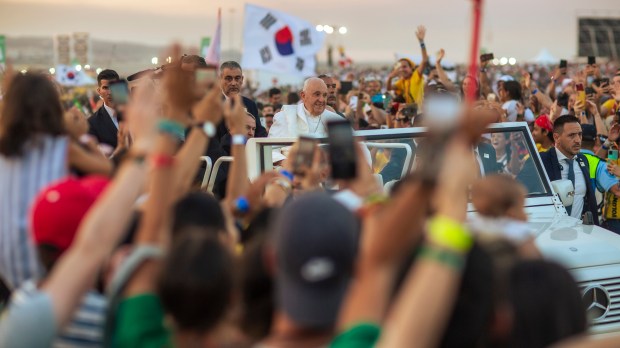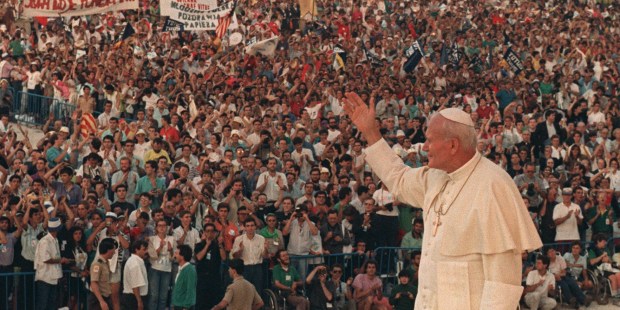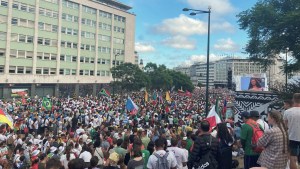A Way of the Cross in St. Peter’s Square on Saturday evening, and two Masses, one celebrated by Portuguese Cardinal José Tolentino de Mendonça on Saturday, and the other by South Korean Cardinal Lazzaro You Heung-sik on Sunday: through these celebrations that took place over the weekend in Rome, a symbolic bridge was created between the 2023 World Youth Day in Lisbon and the 2027 WYD in Seoul, while also commemorating the 40th anniversary of John Paul II launching this event.
Cardinal Mendonça reflected that these youth gatherings are “indispensable moments in the life of the Church.”
“In proclaiming WYD, St. John Paul II dreamed of a youth in love with Christ,” he declared, before a moment of testimonies and prayers around the Cross this weekend.
“Let us always be men of peace, let us pray together for peace in the world, being men and women of peace, living the word of God with the grace of the Holy Spirit,” added Cardinal You, stressing that “St. John Paul II gave the cross to young people because the cross is our peace.”
Very involved in dialogue with North Korea, he also asked those present to pray for his homeland, which will host the next WYD.
John Paul II’s intuition
It was from April 11 to 15, 1984, that Rome saw the first influx of young people from all over the world, under the astonished gaze of the Vatican prelates who were not used to such a festive atmosphere. Observing the crowd from his apartment window, the elderly Cardinal Carlo Confalonieri, who was born in 1893 and had been Pope Pius XI’s secretary before the Second World War, confided to those close to him his emotion at seeing so many young people gathered around the Bishop of Rome.
Italian layman Marcello Bedeschi, today in his 80s, was part of the four-person committee responsible for organizing this first gathering, in conjunction with the Pontifical Council for the Laity.
He was a close friend of the Polish Pope, whom he had known in Krakow since the 1960s.
“John Paul II was always talking to us about young people, remarking on their enthusiasm and their joy at being together. As a priest, then as a bishop and cardinal, he organized a number of meetings in Poland that were, in a way, the first steps towards WYD. This represented a vision of Catholicity as a way of relating to one another as brothers and sisters. When he became pope, he desperately sought an opportunity to put this idea into practice. At the end of the Holy Year of the Redemption in 1983-84, the idea was born of a meeting of reflection and prayer for young people in Rome to enable them to encounter the Lord,” Bedeschi told I.MEDIA last summer, shortly before the WYD in Lisbon.
The first editions
“This first meeting in 1984 attracted young people from 80 countries, which was a great surprise. John Paul II then took the opportunity of the UN International Year of Youth to launch the idea of another meeting, in 1985. This meeting, again in Rome, also worked very well. This led John Paul II to write a letter formalizing the idea of World Youth Days, which would alternate between the diocesan level and a worldwide meeting that would be organized every two or three years,” Bedeschi explained.
As President of the Pontifical Council for the Laity, Argentine Cardinal Eduardo Pironio, who was beatified last December, played a decisive role in the internationalization of these gatherings. It was in fact in Buenos Aires, the capital of his native Argentina, which had recently emerged from a dictatorship, that the first international WYD was organized in 1987. This was followed by two WYDs held in European sanctuaries, in Santiago de Compostela in 1989, and in Częstochowa, in a Poland just liberated from Communism, in 1991.
Over the years, the Polish pontiff paid close attention to the choice of host cities and the development of the programs.
“John Paul II personally oversaw the entire project, including all its details and symbols, such as entrusting young people with the WYD cross so that it could be taken all over the world. This took place even in unthinkable places, including when the cross was smuggled beyond the Iron Curtain into Communist countries. I remember those trips with great intensity,” recalled Bedeschi.
A symbol of the globalization of the Catholic faith
The WYDs later seemingly became like the “Olympics of Faith,” embodying the image of a globalized Church, with the WYDs in Denver in 1993, Manila in 1995, and Paris in 1997. The final Mass at the Longchamp racecourse drew more than a million participants, making it one of the largest gatherings in French history and attracting massive media coverage.
The return to Rome for the following edition, organized as part of the 2000 Jubilee, gave John Paul II, by then weakened by illness, the opportunity to convey to young people a message of hope for the new millennium.
Many of the young pilgrims who attended the event thought it would be their last encounter with John Paul II, but the Polish Pope still found the strength to cross the Atlantic two years later, to take part in the WYD in Toronto in 2002. This event took place in a more serious atmosphere, as North America was still marked by the attacks of September 11, 2001, which had occurred less than a year earlier.
A model continued by Benedict XVI and Francis
Initially seen as more timid than his predecessor and less at ease with large gatherings, Benedict XVI nonetheless continued the WYD model with editions in Cologne, in his native Germany, just a few months after his election in 2005, then Sydney in 2008, and Madrid in 2011. He encouraged the organizers to give more space to times of interiority, silence and adoration, attracting the unexpected support of hundreds of thousands of young people.
His serene presence in the midst of a raging storm at his final WYD gathering in Madrid will remain one of the powerful images of his pontificate, demonstrating the faithfulness of a Pope who remained close to his people, as the weather symbolized beautifully.
Elected in March 2013, Pope Francis’ first international trip was to Brazil the following July, to attend the WYD in Rio de Janeiro. In front of three million faithful, including young people from all over his native Latin America, the first Pope to come from the southern hemisphere touched the soul of his continent with his simplicity and spontaneity. He also didn’t let himself be discouraged by “hiccups” in the organization, such as his escort driving his car into a traffic jam as soon as he arrived.
In Krakow in 2016, in Panama in 2019, and finally in Lisbon in 2023 – which was postponed by a year due to the Covid-19 pandemic – Pope Francis has continued the ministry to young people in search of faith and fraternity.
More WYDs to come!
Although WYDs organized at the diocesan level, now held every Feast of Christ the King, have never had the same impact as these international gatherings, the WYD model remains a central tool for the evangelization of young people. The focus on Asia, with the next gathering planned for 2027 in Seoul, also gives a valuable indication of where Catholicism is growing globally.
And while the financial cost of WYD has sometimes given rise to controversy, Bedeschi sees these gatherings above all as an investment in the future.
“One of the things that moves me the most are the vocations that are born at WYD: priestly, religious, family, professional vocations… For many young people, even in times of crisis, WYD has provided a decisive impetus for their vocation, the orientation of their life. Priests and leaders of Catholic movements need to be aware of this,” Bedeschi insisted, while being happy to see a new generation taking up the torch of this event, now steered from Rome by the Youth Section of the Dicastery for the Laity, Family, and Life.



